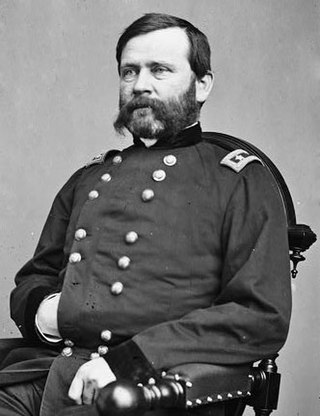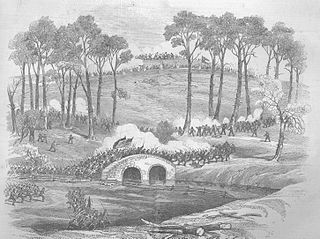
The Battle of the Crater took place during the American Civil War, part of the Siege of Petersburg. It occurred on Saturday, July 30, 1864, between the Confederate Army of Northern Virginia, commanded by General Robert E. Lee, and the Union Army of the Potomac, commanded by Major General George G. Meade.

Ambrose Everts Burnside was an American army officer and politician who became a senior Union general in the Civil War and three-time Governor of Rhode Island, as well as being a successful inventor and industrialist.

The Battle of New Bern was fought on March 14, 1862, near the city of New Bern, North Carolina, as part of the Burnside Expedition of the American Civil War. The US Army's Coast Division, led by Brigadier General Ambrose Burnside and accompanied by armed vessels from the North Atlantic Blockading Squadron, were opposed by an undermanned and badly trained Confederate force of North Carolina soldiers and militia led by Brigadier General Lawrence O'B. Branch. Although the defenders fought behind breastworks that had been set up before the battle, their line had a weak spot in its center that was exploited by the attacking Federal soldiers. When the center of the line was penetrated, many of the militia broke, forcing a general retreat of the entire Confederate force. General Branch was unable to regain control of his troops until they had retreated to Kinston, more than 30 miles away. New Bern came under Federal control, and remained so for the rest of the war.

The siege of Fort Macon took place from March 23 to April 26, 1862, on the Outer Banks of Carteret County, North Carolina. It was part of Union Army General Ambrose E. Burnside's North Carolina Expedition during the American Civil War.
The Battle of Tranter's Creek was fought on June 5, 1862, in Pitt County, North Carolina, as part of Union Maj. Gen. Ambrose E. Burnside's North Carolina expedition during the American Civil War.

The opening phase of what came to be called the Burnside Expedition, the Battle of Roanoke Island was an amphibious operation of the American Civil War, fought on February 7–8, 1862, in the North Carolina Sounds a short distance south of the Virginia border. The attacking force consisted of a flotilla of gunboats of the Union Navy drawn from the North Atlantic Blockading Squadron, commanded by Flag Officer Louis M. Goldsborough, a separate group of gunboats under Union Army control, and an army division led by Brig. Gen. Ambrose Burnside. The defenders were a group of gunboats from the Confederate States Navy, termed the Mosquito Fleet, under Capt. William F. Lynch, and about 2,000 Confederate soldiers commanded locally by Brig. Gen. Henry A. Wise. The defense was augmented by four forts facing on the water approaches to Roanoke Island, and two outlying batteries. At the time of the battle, Wise was hospitalized, so leadership fell to his second in command, Col. Henry M. Shaw.

William Buel Franklin was a career United States Army officer and a Union Army general in the American Civil War. He rose to the rank of a corps commander in the Army of the Potomac, fighting in several notable battles in the Eastern Theater of the Civil War. He also distinguished himself as a civil engineer before and after the war.
The Army of the Ohio was the name of two Union armies in the American Civil War. The first army became the Army of the Cumberland and the second army was created in 1863.
IX Corps was a corps of the Union Army during the American Civil War that distinguished itself in combat in multiple theaters: the Carolinas, Virginia, Kentucky, Tennessee, and Mississippi.

The Battle of Blountville, sometimes (incorrectly) spelled Battle of Blountsville, took place during the American Civil War, occurring on September 22, 1863, in Sullivan County, Tennessee.

The Battle of Blue Springs was a battle of the American Civil War, occurring on October 10, 1863, in Greene County, Tennessee.

The Dismal Swamp Canal is a canal located along the eastern edge of the Great Dismal Swamp in Virginia and North Carolina in the United States. Opened in 1805, it is the oldest continually operating man-made canal in the United States. It is part of the Intracoastal Waterway.

Price's Missouri Expedition, also known as Price's Raid or Price's Missouri Raid, was an unsuccessful Confederate cavalry raid through Arkansas, Missouri, and Kansas in the Trans-Mississippi Theater of the American Civil War. Led by Confederate Major General Sterling Price, the campaign aimed to recapture Missouri and renew the Confederate initiative in the larger conflict.

Jesse Lee Reno was a career United States Army officer who served in the Mexican–American War, in the Utah War, on the western frontier and as a Union General during the American Civil War from West Virginia. Known as a "soldier's soldier" who fought alongside his men, he was killed while commanding a corps at Fox's Gap during the Battle of South Mountain. Reno, Nevada; Reno County, Kansas; Reno, Ohio; El Reno, Oklahoma; Reno, Pennsylvania; Fort Reno (Oklahoma); and Fort Reno Park in Washington, D.C. were named after him.
The Battle of Monroe's Crossroads took place during the Carolinas Campaign of the American Civil War in Cumberland County, North Carolina, on the grounds of the present day Fort Liberty Military Reservation. Involving about 4,500 men, it pitted mounted Confederate cavalry against dismounted Union cavalry. It was one of the last all-cavalry battles of the Civil War. The inconclusive fighting lasted for several hours early on the morning of March 10, 1865. The Confederate attack delayed the United States cavalry's movement toward Fayetteville, denying Brevet Maj. Gen. Hugh Judson Kilpatrick the honor of entering the town first.

During the American Civil War, North Carolina joined the Confederacy with some reluctance, mainly due to the presence of Southern Unionist sentiment within the state. A popular vote in February, 1861 on the issue of secession was won by the unionists but not by a wide margin.

Black Warrior is the name of a Confederate two-masted schooner that participated in the defense of Roanoke Island in North Carolina during the Civil War. Its brief wartime career ended with its burning at Elizabeth City, North Carolina.

Marks' Mills Battleground State Park is an Arkansas State Park located at the junction of Arkansas Highway 8 and Arkansas Highway 97, north of New Edinburg, Arkansas. It preserves a portion of the battlefield of the Battle of Marks' Mills fought on April 25, 1864, in the Trans-Mississippi Theater of American Civil War. The battle was part of the Camden Expedition. The park is one of nine historic sites that make up the Camden Expedition Sites, a National Historic Landmark District. The battle was most known for the slaughter of black Union soldiers that were murdered as they tried to surrender.
Burnside's North Carolina Expedition was a series of engagements fought along the North Carolina Coast between February and June 1862. The expedition was part of Winfield Scott's overall Anaconda Plan, which aimed at closing blockade-running ports inside the Outer Banks. The amphibious operation was carried out primarily by New England and North Carolina troops under Brig. Gen. Ambrose E. Burnside and assisted by the North Atlantic Blockading Squadron under Captain Louis M. Goldsborough.

The 21st Massachusetts Infantry Regiment was an infantry regiment in the Union Army during the American Civil War. It was organized in Worcester, Massachusetts and mustered into service on August 23, 1861.















